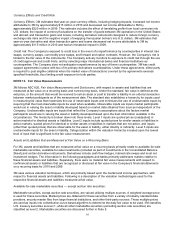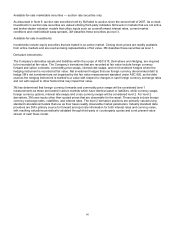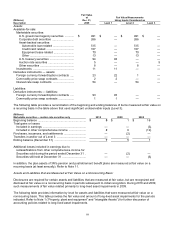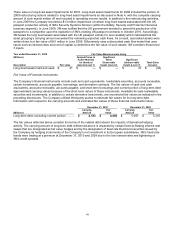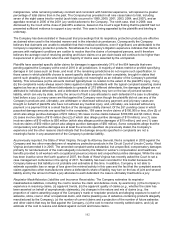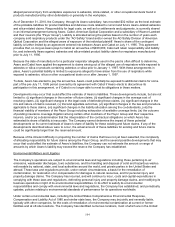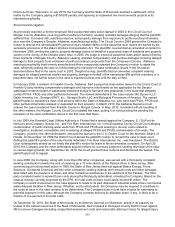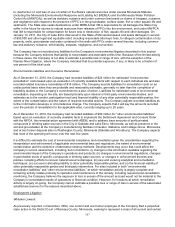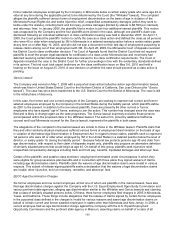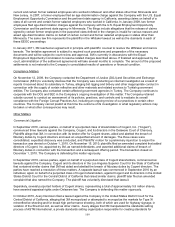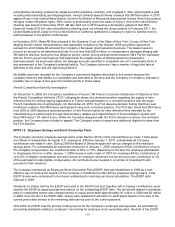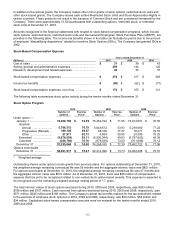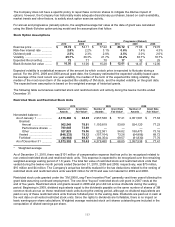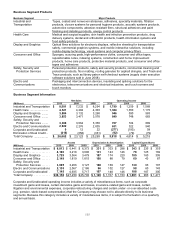3M 2010 Annual Report Download - page 111
Download and view the complete annual report
Please find page 111 of the 2010 3M annual report below. You can navigate through the pages in the report by either clicking on the pages listed below, or by using the keyword search tool below to find specific information within the annual report.105
States, at which it may have some liability. Please refer to the paragraph entitled “Environmental Liabilities and
Insurance Receivables” that follows for information on the amount of the reserve.
Environmental Matters
As previously reported, the Company has been voluntarily cooperating with ongoing reviews by local, state, national
(primarily the U.S. Environmental Protection Agency (EPA)), and international agencies of possible environmental
and health effects of various perfluorinated compounds (“PFCs”), including perfluorooctanyl compounds
(perflurooctanoic acid or “PFOA” and perfluorooctane sulfonate or “PFOS”). As a result of its phase-out decision in
May 2000, the Company no longer manufactures perfluorooctanyl compounds, and through changes to its
manufacturing process at the end of 2008, no longer uses such compounds in its manufacturing process.
Regulatory activities concerning PFOA and/or PFOS continue in Europe and elsewhere, and before certain
international bodies. These activities include gathering of exposure and use information, risk assessment, and
consideration of regulatory approaches.
In late 2008 and early 2009, the EPA implemented testing of private wells and soils at certain agricultural sites in
Alabama where wastewater treatment sludge was applied from a local wastewater treatment plant that received
wastewater from numerous industrial sources. In this same timeframe, the EPA also issued provisional health
advisory values for drinking water for PFOA of 0.4 parts per billion (“ppb”) and PFOS of 0.2 ppb. The EPA currently
believes that these levels are protective of drinking water supplies for a lifetime of consumption and is working with
local industry, including 3M, to continue testing private wells in the area. EPA’s past testing of public drinking water
supplies in Lawrence and Morgan Counties indicate that the levels of PFOA and PFOS are well below the provisional
health advisories. 3M and other companies are completing the survey of properties near the sites where wastewater
treatment sludge was applied to determine if any further private drinking water wells are present and will continue to
monitor for another quarter those few wells that showed levels of PFOS or PFOA above detection levels but below
the EPA’s provisional health advisory levels. In late 2010, four new wells were identified which will be tested
according to the protocol agreed to with the EPA. If any private wells are found to exceed the EPA’s provisional
health advisory levels, 3M and the other companies will provide alternative water supplies.
As previously reported, the Company entered into a voluntary remedial action agreement with the Alabama
Department of Environmental Management (ADEM) to address the presence of PFCs in the soil on the Company’s
manufacturing facility in Decatur, Alabama. For approximately twenty years, the Company incorporated wastewater
treatment plant sludge containing PFCs in fields surrounding its Decatur facility pursuant to a permit issued by
ADEM. After a review of the available options to address the presence of PFCs in the soil, ADEM agreed that the
preferred remediation option is to use a multilayer cap over the former sludge incorporation areas on the
manufacturing site with groundwater migration controls and treatment. Implementation of that option continued
throughout 2010 and is expected to be completed in 2014.
The Company continues to work with the Minnesota Pollution Control Agency (MPCA) pursuant to the terms of the
previously disclosed May 2007 Settlement Agreement and Consent Order to address the presence of perfluorinated
compounds in the soil and groundwater at former disposal sites in Washington County, Minnesota (Oakdale and
Woodbury) and at the Company’s manufacturing facility at Cottage Grove, Minnesota. Under this agreement, the
Company’s principal obligations include (i) evaluating releases of perfluoronated compounds from these sites and
proposing response actions; (ii) providing treatment or alternative drinking water upon identifying any exceeded level
of a Health Based Value (“HBV”) or Health Risk Limit (“HRL”) (i.e., the amount of a chemical in drinking water
determined by the Minnesota Department of Health to be safe for people to drink for a lifetime) for any perfluoronated
compounds as a result of contamination from these sites; (iii) remediating any source of other PFCs at these sites
that is not controlled by actions to remediate PFOA and PFOS; and (iv) sharing information with the MPCA about
perfluoronated compounds. During 2008, the MPCA issued formal decisions adopting remedial options for the former
disposal sites in Washington County Minnesota (Oakdale and Woodbury). In August 2009, the MPCA issued a
formal decision adopting remedial options for the Company’s Cottage Grove manufacturing facility. During the spring
and summer of 2010, 3M began implementing the remedial options at the Cottage Grove and Woodbury sites. 3M
commenced the remedial option at the Oakdale site in late 2010. At each location the remedial options were among
those recommended by the Company. Remediation work will continue at all three sites in 2011.
The Company cannot predict what additional regulatory actions arising from the foregoing proceedings and activities,
if any, may be taken regarding such compounds or the consequences of any such actions.
In March 2010, the Wisconsin Department of Justice notified the Company that it is seeking $270,000 in penalties for
alleged past violations of the Wisconsin Air Management regulations at the Company’s manufacturing facility in


